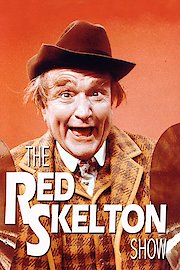
Ep 7. Phantom Of The Ballet
- November 29, 1955
- 26 min
The Red Skelton Show season 5 episode 7, titled Phantom Of The Ballet, is a delightful comedic journey that takes viewers behind the scenes of a fictional ballet production, blending humor, music, and a sprinkle of theatrical charm. In this episode, the beloved comedian Red Skelton showcases his exceptional talent for physical comedy and mimicry, diving deep into the world of dance and performance while playfully illuminating the quirks of the industry.
As the episode opens, the stage is set for a grand ballet performance, with Red in the role of a bumbling yet well-meaning stagehand. His character’s misadventures and misunderstandings set the tone for a lighthearted exploration of the ballet scene. The production vibrates with a sense of excitement, as Red's antics quickly establish him as the comedic heartbeat of the show, creating a stark contrast to the graceful and poised dancers who fill the stage.
Red Skelton is known for his ability to connect with audiences through his warm demeanor and expressive physicality, and in Phantom Of The Ballet, he brings an array of eccentric characters to life. In addition to his role as the stagehand, viewers will be treated to a series of hilarious vignettes featuring some of his well-known alter egos, such as the mischievous country bumpkin and the flamboyant and manic clown. These characters not only amplify the episode’s comedic value but also highlight Skelton’s innate ability to capture the essence of various personalities in a way that resonates with audiences of all ages.
The episode features guest appearances that shine a spotlight on ballet dancers and musicians, demonstrating the collaborative nature of performing arts. The interactions between Skelton and these skilled performers create a rich tapestry of comedic moments, beautifully blending slapstick humor with elegant ballet sequences. As Red hilariously attempts to navigate the intricacies of the ballet world, he inadvertently triggers a series of comic disasters that keep the audience laughing while simultaneously showcasing the artistry of ballet.
Another layer to the episode is the exploration of the concept of a "phantom," a common trope in theatrical lore. Red’s character may encounter rumors of a ghost haunting the theater, which prompts a variety of comic interpretations of what that may entail. The blend of spooky humor with the bustling energy of the ballet serves as a perfect backdrop for Skelton’s slapstick routines, allowing him to seamlessly transition between physical comedy and witty dialogue.
The physicality of Skelton’s performance is further enriched by the visual spectacle of the ballet dancers, who provide a mesmerizing counterpoint to his comedic style. Their grace and precision highlight the absurdity of Red’s character and the situations he finds himself in, allowing for a dialogue between humor and artistry. Viewers will appreciate the skillful choreography, as well as Skelton's comedic timing, which turns the stage into a dynamic playground of movement and laughter.
As the episode progresses, expect delightful musical numbers that serve to elevate the performance. Red Skelton’s musical talents come into play as he both sings and dances, adding another dazzling layer to the episode. The interplay of song and dance not only boosts the entertainment factor, but also connects the rhythm of ballet with the beat of Skelton’s humor.
Phantom Of The Ballet is ultimately a tribute to the world of theater, celebrating its mischief, magic, and passion. Red Skelton navigates through the ups and downs of being on stage, giving insight into the camaraderie among performers and the chaos that can ensue behind the curtains. The episode is filled with clever gags and routines, making it a memorable installment that both honors and pokes fun at the realm of ballet.
In conclusion, The Red Skelton Show’s phantom-filled ballet episode encapsulates the essence of variety television in the 1950s. With a perfect blend of laughter, music, and dance, it captures not just a moment in theatrical history, but also the heartwarming spirit of friendship and collaboration within the performing arts. This episode promises to be not only a feast for the eyes and ears, but also a balm for the soul, making it an essential watch for fans of classic comedy and performance alike.
